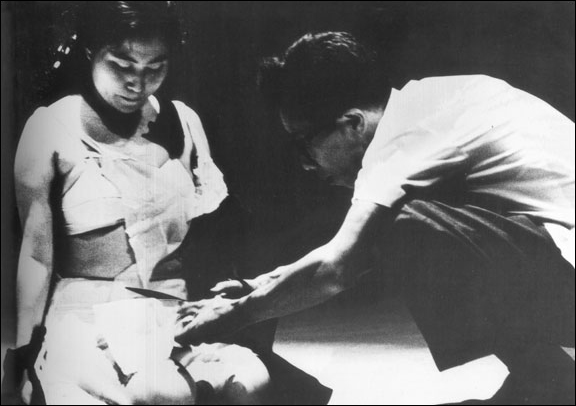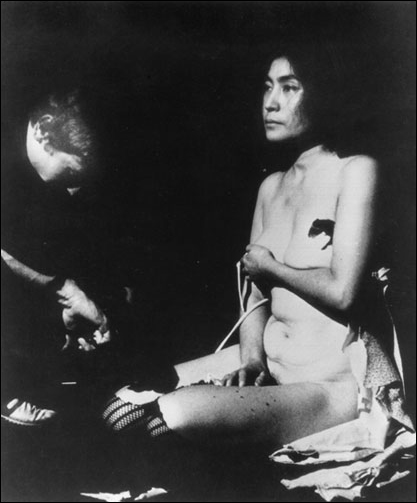Yoko Ono’s Cut Piece at the Ise Foundation
CUT PIECE
Cut.
y.o.
On July 20, 1964 in Kyoto, Japan, Yoko Ono entered a stage dressed in her finest clothes carrying scissors. She calmly made her way to center stage and invited the audience to cut off her clothing. Ono then knelt on the stage with her legs tucked beneath her and waited. One by one, members of the public mounted the stage to clip away clothing from her body with the scissors.

Trusting Fifty Strangers
The concept of trusting a roomful of strangers with a sharp instrument to cut away all the clothing from one’s body, in all its vulnerability, seems as radical today as it must have forty years ago. Ono’s work challenges the relationship between artist and public and establishes a powerful, non-verbal dialogue based on trust. The artwork becomes a collaborative project which grows out of touch and the elimination of garments which obscure the true nature of all the participants in the room.
Whenever there is a situation based upon trust, a person can choose to violate it. This happened during a performance of Cut Piece in Kyoto, when a man raised the scissors above Ms. Ono’s head and began to threaten her with it. By not feeding this man’s negative energy with fear, she overcame his base approach to the piece, which continued without incident.
I am less drawn to interpretations of Cut Piece based on the sadomasochistic relationship between participants. Rather Ms. Ono demonstrates that with grace and simplicity people can confront such inner demons as fear, distrust, and violence, and vanquish them from daily life through the force of will. Yoko Ono’s body has a powerful sexual, sensual, creative manna, which certainly becomes part of the piece. But Ono has stipulated that the work can also be performed by a man. The threat of castration or violation with the scissors intensifies the experience while reinforcing the need to respect the safety of others in the room through a communion of trust.

The Buddha and the Tigress
In one of his previous lives as a Bodhisattva, the Buddha was born as Prince Mahasattva. One day he and his two brothers were out walking and they came upon a starving tigress, surrounded by her cubs. The three princes were very troubled and Mahasattva asked his brothers to leave him for a while. Mahasattva then lay down before the tigress and slit his throat with a piece of bamboo so that the tigress could feed upon his flesh.
Cut Piece can be looked upon as an act of symbolic sacrifice, in which the clothing represents a surrogate flesh. The tiger manifests itself within each member of the audience in the form of fear, subterranean urges and desires. From the pascal lamb to Abraham and Isaac to Jesus Christ in the Western tradition this theme of redemption through sacrifice recurs many times. Perhaps today the concept manifests itself in a more powerful, universal way, through art in a common, direct experience of Cut Piece.
Water Piece

Water, an element that fills all of our bodies, is a recurrent motif in Yoko Ono’s work. The Water Piece instruction painting of 1962, refers to a conceptual oasis from which paintings germinate, take root, and grow in the mind. By way of this instruction, Ono suggests that anyone who cares enough to tend and water it, can nurture the growth of a painting. Art, like agriculture, thrives on a benevolent combination of elements and gardeners. The creation of a painting through a shared memory of water (and the womb) speaks to interior growth through an understanding of the unity between personal and collective experience.
Touch Piece
Touch Piece is generally performed in the following way: lights are turned off and members of the audience feel one another from anywhere between ten minutes and two hours. At the Tanzen Temple in Kyoto Japan, the piece lasted from dusk until dawn. For New Yorkers, Touch Piece may have particular significance. Each day city-dwellers clad themselves in psychological armor which strongly inhibits their ability to empathize with strangers. Touch Piece forces participants to eliminate barriers to communication and understand the body of another through the sensual language of touch, awakening myriad sensations and emotions that lie dormant in their daily lives.

Grapefruit
Grapefruit: Yoko Ono in 1964 will be on view at the Ise Cultural Foundation through May 15, 2004. Curated by Midori Yamamura, this exhibition focuses on Ono’s artistic production in the year 1964, which saw the publication of Grapefruit, the artist’s collected instruction paintings. In 1964, Yoko Ono decided to return to New York City after working in Japan for two years. Artists Nancy Hwang, Hiroko Kikuchi, and the artist collective Praxis interpreted Ono’s instructions for Touch Piece, Cut Piece, and Water Piece on three consecutive Saturdays in April. The Ise Cultural Foundation is located at 555 Broadway (between Prince and Spring Streets) Telephone 212-925-1649.
© 2004 Daniel Rothbart. All rights reserved.